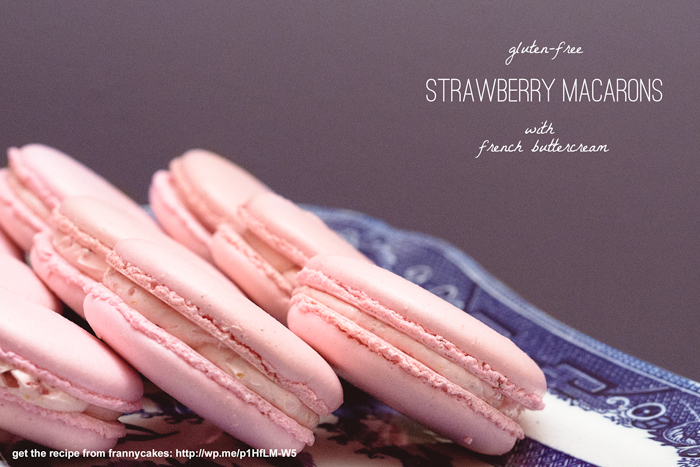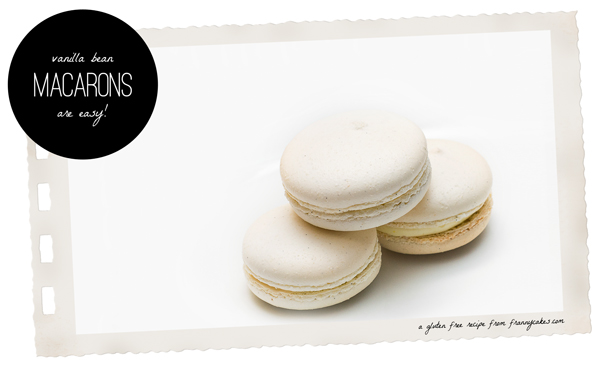Ah, the macaron. It might just be the perfect cookie. Crunchy. Chewy. Dreamy. With just a little bit of cream filling. Seriously, who needs a boyfriend when a cookie like this exists? They totally love you back. I swear.
Wait, I can’t be in love with a cookie? If you say so. But, before we go any further, I need to make sure that you are clear on the difference between a macaron and a macaroon. Macaroons are those chewy coconut cookies with a cherry on top. Macarons are the french delight that is two merengue and almond shells with a lovely filling in the middle.
I even made a little diagram of what makes a macaron (ok, I might be a little obsessed. I am totally fine with that.)

I decided to make macarons again when I discovered that MammaCakes had made some home made strawberry jam. Strawberries and almonds make a great combo (last summer I made this Strawberry Frangipane Tart with this same flavor profile).
I even made french buttercream for the center of the gluten-free strawberry macarons as a way to use up all the yolks left behind from the merengue. Planning ahead, it gets you every where. And by everywhere I mean that it gets you to velvety smooth buttercream.

Now, let’s talk about how you go about adding flavor and color to a macaron.
- Use gel food coloring. You don’t want to change the texture of the merengue by introducing liquid. A gel will not alter the consistency as much. And remember, a little goes a long way.
- It is easiest to flavor the filling. The brain is a magic place, colors that match the flavor of the filling send a signal to your brain that the shell is flavored too. Even if it isn’t. Also, flavor elements can change the texture of the shell, so stick to changing the type of nut or the flavor of extract you use rather than try to add a puree to the merengue.
- Make a bulls eye. Creating a ring of buttercream around a jam will keep it from leaking out the sides.

- For the shells
- 212 grams (1¾ cups + 2½ tablespoons) almond meal
- 212 grams (1¾ cups + 1 tablespoon + 2 teaspoons) confectioners’ sugar
- 82 (1/4 cup plus 1½ tablespoons) egg whites
- 90 grams egg whites (1/4 cup plus 2 tablespoons – this is about 7-8 whites) egg whites (yes, you need both quantities, divided)
- 1 vanilla bean, slit open
- 236 grams granulated sugar (1 cup plus 3 tablespoons), plus a pinch (about 5 grams)
- 158 grams (2/3 cup) water
- Pink gel food coloring
- 3-4 tablespoons of strawberry jam or preserves
- 1 recipe Strawberry French Buttercream (recipe below)
- Cut 2 sheets of parchment paper to fit your cookie sheets. Trace 2¼ inch circles with a fine point marker like a Sharpie approximately 1 inch apart in alternating rows of 3 & 4. Turn the parchment paper over and lay it on your sheet pans/ cookie sheets.
- Preheat the oven to 350°F (convection) or 400°F (standard).
- Place the almond flour in a food processor and pulse to grind it as fine as possible. This is really not an optional step unless your almond meal is ultra fine. Most isn’t, and skipping this step can leave you with lumpy macarons. (Although the flavor won’t be bad)
- Sift the almond flour and powdered sugar into a large bowl and whisk together. If you have more than a couple of tablespoons of almonds remaining in the sifter, re-grind the flour in the food processor. Create a mound in the bowl with the almond flour mixture, then make a 4-inch well in the center, leaving a layer of the flour at the bottom. Pour in the 82 grams | ¼ cup plus 1½ tablespoons egg whites and combine with a spatula, stirring until evenly distributed and paste-like. Scrape the seeds from the vanilla bean into the bowl and mix until they are fairly well distributed. Set aside.
- Place the remaining 90 grams (1/4 cup plus 2 tablespoons) of the egg whites into the bowl of a stand mixer fit with a whisk attachment. In a small saucepan, combine the 236 grams (1 cup plus 3 tablespoons) granulated sugar and the water and heat over medium-high heat until the syrup reaches 203°F/110°C, stirring only until the sugar is dissolved and the mixture is clear.
- While the syrup continues to cook, add the pinch of sugar to the egg whites, turn the mixer to medium speed (a 5 or 6 on my mixer), and whip to soft peaks. If the whites reach soft peaks before the syrup reaches 248°F/12o°C, reduce the speed to the lowest setting, just to keep them moving.
- When the syrup reaches 248°F/120°C, remove the pan from the heat. Turn the mixer to medium-low speed, and slowly add the syrup, pouring it between the side of the bowl and the whisk. Do not panic when the meringue deflates.
- Increase the speed to medium and whip for 5 minutes, or until the whites hold stiff, glossy peaks. Although the bowl might still be warm to the touch, the meringue should have cooled; if not, continue to whip until it is cool.
- In the bowl with the almond mixture, fold in one-third of the meringue, then continue adding merengue to the almonds little at a time (you might not use them all – I used about 90% each time I have made these. You can pipe the left over plain merengue out when you are done and make little pavlova shells) until when you fold a portion of the batter over on itself, the “ribbon” slowly moves. The mixture shouldn’t be so stiff that it holds its shape without moving at all, but it shouldn’t be so loose that it dissolves into itself and does not maintain the ribbon; it is better for the mixture to be slightly stiff than too loose. So go slowly! Take your time! You want to make sure that your mixture does not have any ribbons of plain merengue, where there are no almonds or your shells could crack.
- Fold in a small amount of gel food coloring while you are adding your merengue. If you want a more intense color once your mixture is uniform, you can add a smidge more, but you don’t want to over mix and deflate your batter.
- Transfer your mixture to a pastry bag fit with a ½-inch plain tip. Hold the bag upright about a half inch above the center of one of the traced circles and pipe out enough of the mixture to fill in the circle. Lift away the pastry bag and repeat, filling the remaining circles on the first pan.
- Next (and this is important!) Lift up the sheet pan and firmly (but not too hard) tap the bottom of the pan to the spread the batter evenly and smooth any peaks left by the pastry bag (there will be some, and if that doesn’t make them go away, wet your fingertip and tap them down).
- If you are using a convection oven, which I recommend, bake the shells for 8 to 10 minutes. You want to cook them until the tops are shiny and crisp. If you are using a standard oven, place the sheet pan in the oven and then immediately lower the oven temperature to 325°F, and bake for 9 to 12 minutes, again, until the tops are shiny and crisp.
- Set the pan on a cooling rack, and if using a standard oven, preheat it to 350°F again.
- Pipe the remaining meringue mixture into the circles on the second sheet pan and bake as directed above. Let cool completely.
- While you are waiting for your cookies to cool, make
- Pipe a circle of buttercream on half of the macaroni shells, leaving the center empty, I used a wide plain circle tip but held the bag close to the shell to keep the circle wide & flat. Pipe or dollop jam in the middle, and gently place a second shell on top.
- 38 grams (3 tablespoons + 1/2 teaspoon) granulated sugar
- 38 grams (3 tablespoons + 1/2 teaspoon) granulated sugar (You do need both quantities, and yes, they are both the same)
- 63 grams (1/4 cup + 1/2 teaspoon) egg yolks
- 75 grams (1/4 cup + 2 1/4 teaspoons) whole milk
- 250 grams (8.8 ounces) unsalted butter, cut into 1/2 inch cubes at room temperature
- 1/2 teaspoon salt
- 2 tablespoons strawberry preserves or jam
- Whisk 38 grams of sugar and the egg yolks together in a medium bowl and set aside.
- In a medium sauce pan over medium heat, combine the remaining 38 grams of sugar and the milk.
- Stir to dissolve the sugar.
- When the milk is just below a simmer, slowly pour it into the egg yolks while whisking. Pour the combined mixture back into the pan and place over medium heat.
- Whisk continuously and bring to a gentle simmer and simmer for one minute. Lower the heat if necessary – you don’t want the mixture to curdle. It should be very thick.
- Remove from the heat and strain through a fine-mesh strainer into the bowl of a stand mixer.
- Fit the mixer with the whisk attachment and whisk on medium for 8 minutes, or until mixture is cool.
- Add the butter a little at a time, waiting between each new addition.
- When you have all the butter added, mix in the salt and the jam.


 There are some things I have always wanted to try but have been slightly (or not so slightly) intimidated by. Now that FrannyCakes has matured a little bit, I want to start tackling these items one by one.
There are some things I have always wanted to try but have been slightly (or not so slightly) intimidated by. Now that FrannyCakes has matured a little bit, I want to start tackling these items one by one.